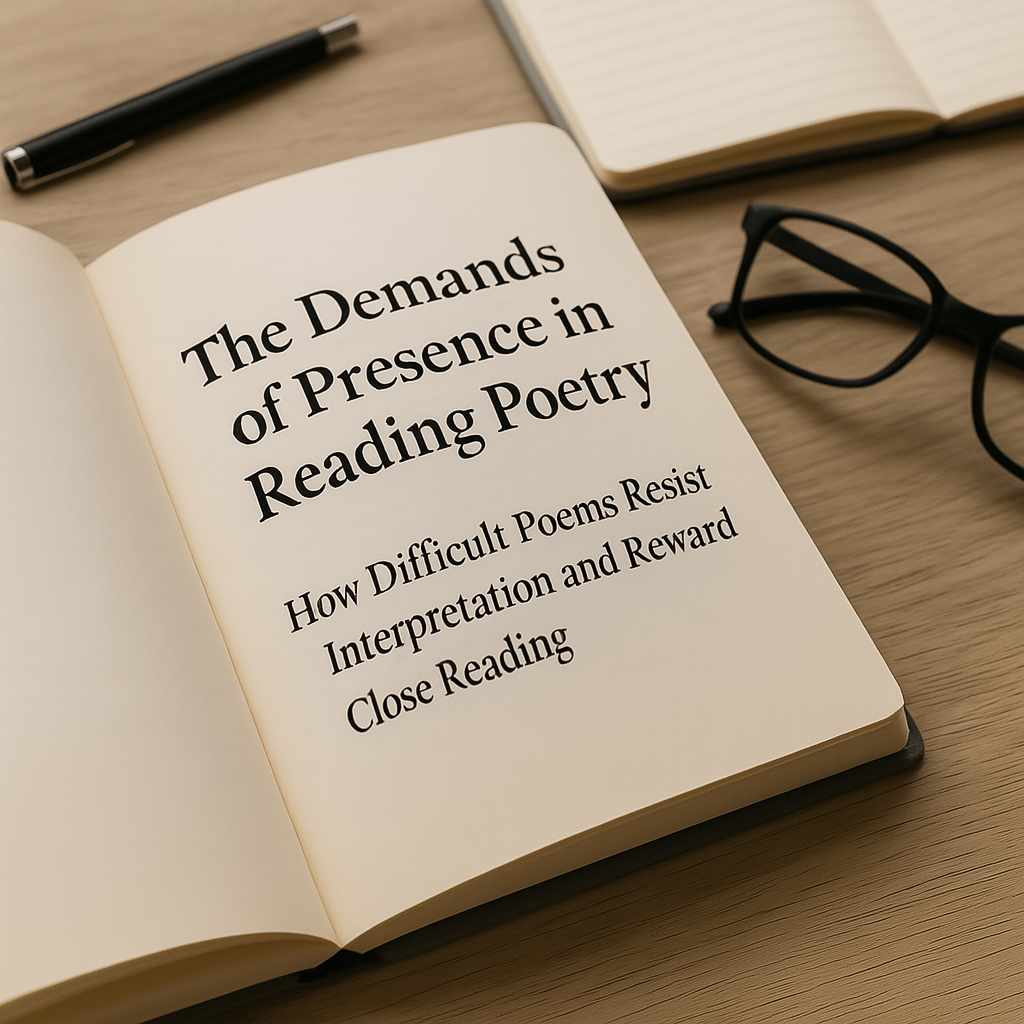Certain poems are purposefully left unfinished. Their essence is held in suspension; they avoid single formulation and offer no simple path to understanding. This refusal transcends simple style or temperament; it reflects an intentional construction of language that cannot be reduced to a simplified explanation. These poems do not articulate their arguments clearly at the outset. Engaging with poetry of this kind requires a different attention, one that slows the pace of engagement and averts the reader’s anticipation of a definitive ending.
What often gets labeled as “difficult” in poetry has more to do with the kind of engagement a poem demands. Dense, formally intricate work doesn’t fail to impart; it communicates through pressure—on syntax of language, on reticence, on the reader’s habits of interpretation. These poems are not meant to be consumed in a single sitting. They are constructed for rereading, and the rereading changes the poem. What’s asked of the reader is not deference or patience, but rigor.
The Conditions of Difficulty
Precision and Compression
One of the central features of difficult poetry is its economy. Every word is chosen under constraint. There is no excess, no cushioning, no effort to accommodate the casual reader. When poems employ compression, the linguistic element does more than communicate a message; its very existence carries profundity. Syntax is pared down, often rearranged, so that clarity is achieved only through close scrutiny. The result is a kind of density that rejects casual interpretation; its characteristic is precision, not a conscious lack of clarity.
Compression also alters the rhythm of attention. A line that carries several interpretations at once cannot be scanned lightly. It slows reading without signaling difficulty in any overt way. The pressure resides in how much is implied, not how much is said. This is why the most precise poets are often misread as difficult: they ask more of the reader by giving less on the surface.
Example: Ezra Pound, “In a Station of the Metro” (1913)
The apparition of these faces in the crowd;
Petals on a wet, black bough.
These fourteen words enact compression at its most acute. Pound eliminates verbs, connector words, even articles. Two images collide—faces, petals—each suggesting presence yet withholding narrative. The connection between them is not spelled out; instead, meaning resides in the reader’s associative leap. That sudden juxtaposition electrifies the line. The poem’s power emerges from what remains unstated.
This utter narrowness—zero exposition, pure image—exemplifies the poem’s difficulty not as opacity but as intensity. Signification arises from pressure, not clarification. Each punctuation mark takes on immense importance. Every word conveys an impulse that seeks to be grasped but is not demanded outright.
Ambiguity Without Vagueness
Ambiguity in serious poetry is not a failure of articulation. It is a deliberate refusal to narrow explication prematurely. A line might hinge on a double meaning, a shift in grammatical emphasis, or a word whose context remains incomplete until the final stanza—or never resolves at all. But ambiguity does not imply vagueness. The poem holds together structurally even if its significance remains open.
This kind of ambiguity opposes interpretation that seeks closure. It frustrates attempts to reduce a poem to its “message” because it is never purely referential. Inference unfolds through the interplay of tone, structure, rhythm, and diction. For readers accustomed to coherence framed by argument or narrative arc, this quality can feel disorienting. But for those willing to engage on the poem’s terms, ambiguity becomes a source of depth rather than confusion.
Example: Robert Frost, “Nothing Gold Can Stay” (1923)
Nature’s first green is gold,
Her hardest hue to hold.
These opening lines appear deceptively simple, structured in iambic trimeter with a tight rhyme scheme AABBCCDD. Yet within this economy lies ambiguity. “Gold” operates both as color and metaphor, suggesting purity, ephemerality, and loss. The shift from image to idea happens inside two short lines. The poem moves from nature into the fragile tension that defines human experience.
Though the diction is clear and the meter regular, these lines convey a richness, facilitating diverse interpretations. Is “gold” a literal color or a metaphor for purity and value? Does “hold” refer to physical retention or to emotional grasp? The ambiguity lies in the intersection of literal description and metaphorical resonance—an elegant tension that opens the poem rather than closing it.
Fully eight lines long, Frost’s lyric folds natural observation into existential insight. The final couplet—“Nothing gold can stay.”—reads like a proverb, yet resonates as elegy. The compression—one dozen lines—delivers acuity without drift. The poem cannot be paraphrased precisely because its significance lives in the interaction between meter, image, and resonance.
Disruption of Familiar Forms
Many poets working at the edge of readability achieve their effects by undermining conventional forms. The disruption might be formal—such as abandoning meter or punctuation—or syntactic, through fragmentation and enjambment that distort the flow of thought. These disruptions are not gestures of defiance. They are methods of reordering attention, making the reader conscious of how language structures perception.
By refusing familiar cues, the poet prevents the reader from coasting on assumption. A sentence that unfolds across five lines without punctuation alters the pace and the balance of meaning. A stanza that breaks off mid-thought forces a reassessment of what has come before. These disruptions are integral to the poem’s logic. They are not experiments in difficulty; they are strategies of control.
Example: Emily Dickinson, “I never hear that one is dead” (Poem #1325)
I never hear that one is dead /
Without the chance of Life /
Afresh annihilating me /
That mightiest Belief,
In these four lines, Dickinson avoids terminal punctuation until the end, so each phrase flows into the next with cumulative power. A shift in meaning occurs mid-stanza: the reader begins thinking about “one is dead,” then discovers the speaker feels life being “annihilated,” and finally encounters “That mightiest Belief,” which refracts the previous lines. The enjambment guarantees that the first interpretation never settles, pulling the reader forward—and backward—through shifting syntactic relationships.
The poem begins with the declarative “I never hear that one is dead,” a clause that appears syntactically stable. But the enjambment that follows upsets this impression. The “chance of Life” arrives as a grammatical redirection, while “Afresh annihilating me” overturns the hopeful register into something far darker. Only at the end—“That mightiest Belief”—does the reader confront a kind of explanation, but even this conclusion is ambiguous. Is it the belief in resurrection or in death’s finality? The sentence coils rather than progresses.
Dickinson uses enjambment here not to interrupt for effect, but to destabilize the reader’s interpretive grounding. The conventional arc of statement followed by reinforcement is replaced by a series of disorienting turns, each line interrupting or recontextualizing the last. Grief and metaphysics blur together. Substance becomes less an outcome than a field of unresolved tension. The formal disruption is achieved through the radical recalibration of syntax, surpassing abandonment.
Rereading and the Poem That Outlasts First Impressions
The Role of Return
A poem that sustains rereading is structured to withstand familiarity. It endures engagement even after its formal patterns are mapped, its references traced, and its metaphors decoded. Instead of altering it, the act of returning does not diminish its potency. New tonal shifts emerge; previously overlooked structural decisions begin to acquire relevance. What was once an image now becomes an argument; what first registered as ornamental now reveals a pattern of emphasis.
This change results from the poem’s plural import, not from withholding thematic content. Each rereading reframes the original encounter, extending the life of the text beyond its first reading. This is particularly true of works where structure and sound influence comprehension as much as content. In such cases, attention to cadence or enjambment can interfere with even well-established interpretations. The poem functions as a pattern of language to be inhabited over time, exceeding the role of a simple statement to be grasped.
Rereading as Method
There is a difference between rereading to confirm and rereading to discover. The former is an act of verification—seeking to affirm an interpretation already formed. The latter is a method of inquiry, one that acknowledges how easily understanding shifts when language is reencountered under different conditions. A poem that provokes the second kind of reading does not offer resolution; it offers recurrence. Its design contains more than it can display at once.
This method of re-engagement is not an indulgence; it accurately reflects the internal logic of the poem. Some works are built from recurrence and variation, while others conceal a structure that only becomes apparent when the poem is seen in its entirety—and then reconsidered in its parts. Syntax, lineation, and rhythm must be studied in motion. A poem that survives this level of scrutiny does not simply last; instead, it accumulates authority.
Example: Wallace Stevens, “The Snow Man” (1921)
For the listener, who listens in the snow,
And, nothing himself, beholds
Nothing that is not there and the nothing that is.
The final three lines of Stevens’ poem are often cited for their philosophical intricacy, but their rhetorical construction is equally remarkable. The balance of negation—“nothing that is not there” and “the nothing that is”—induces both logical parsing and metaphysical speculation. The sentence folds back on itself, forcing the reader to reconsider what has been seen, heard, and thought in the poem up to that point. No single reading settles it.
Returning to this poem rarely clarifies it in the traditional sense. Instead, it reopens its ambiguities. The emotional tone shifts depending on the reader’s orientation—detachment, bleakness, equanimity. Its compactness and syntactic delicacy demand ongoing attention, precisely because each reading reframes the entire structure of perception it presents.
The Poem as a Site of Ongoing Attention
What distinguishes enduring poetry is the kind of attention it trains in the reader, beyond the mere presence of complexity. Close rereading is a process of attunement, not simple decoding. The poem’s import arrives through proximity—the decision to read slowly, to repeat a line aloud, to notice the hesitation in a break or the recurrence of a vowel. These are not passive acts. They require effort, and that effort transforms the reader’s relation to language as a whole.
This type of reading does not prioritize conclusions. It rewards attentiveness, and it sharpens the reader’s capacity to stay with what is unresolved. In doing so, it produces a different mode of understanding: recognition is achieved not by interpretation alone, but by grasping that a poem can extend beyond its own explicit statement.
Example: George Herbert, “The Collar” (1633)
I struck the board, and cried, “No more;
I will abroad!
Herbert’s poem begins with rebellion and disorder. Its syntax is jagged, propelled by interruption and self-contradiction. The speaker argues with himself across stanzas, shifts frequencies abruptly, and refuses formal containment.
On first reading, the poem appears chaotic, impulsive, emotionally precarious. But with each rereading, its intricate design becomes more visible. The apparent spontaneity is underwritten by rhetorical control. The final lines—where a voice, presumably divine, says “Child!” and the speaker answers “My Lord.”—offer resolution but do not explain. They retroactively reframe the preceding turmoil, though without negating it.
“The Collar” is rewarding when read again because its progression through doubt, defiance, and surrender possesses structural instability, instead of simply being difficult due to theology. Each time the poem is revisited, its tonal balance and internal rhythm shift slightly, creating new tensions within the same textual boundaries.
Poets of Lasting Difficulty: A Selective Reading List
This section presents a selection of poets whose works are excellent instances of poetry that reward sustained engagement. Each poet is treated in two paragraphs: the first situates their contribution to poetry and literary thinking; the second examines how their difficulty operates—whether through form, voice, structure, or conceptual ambition. The focus is not on difficulty for its own sake, but on what that difficulty produces: poems that do not diminish with time, that stay present to their readers across rereading, and that avoid simple conclusions.
T. S. Eliot
T. S. Eliot stands as one of the defining poets of the twentieth century precisely because his poems remain difficult without becoming impenetrable. His early work established a new mode of poetic thought while his later poems drew on theological, philosophical, and liturgical sources. In both cases, he built his poetry to withstand interpretive exhaustion. His lines do not resolve easily into simplification, and his references demand serious engagement rather than mere annotation. Eliot does not simply write about disorder and belief; he builds poems that enact both.
In Four Quartets (1943), Eliot constructs a sequence of meditative poems that intertwine temporal reflection, metaphysical inquiry, and historical allusion. The architecture is musical, recursive, and densely structured. Each movement circles back to a central concern—time, mortality, spiritual renewal—without offering finality. The reader is caught in a loop of argument and image, statement and retreat. The difficulty arises not from obscurity but from scope. Eliot’s ambition was not to simplify experience but to make its complexity legible through poetic form.
Louise Glück
Louise Glück’s poems appear spare at first glance—short lines, plain diction, little ornamentation. Yet beneath the surface, her work carries a psychological intensity and formal precision that deter quick interpretation. Her subjects—loss, family, myth, isolation—are examined through language that is both restrained and unsparing. Glück does not raise her voice but sharpens it. Her lyric speakers often operate at a distance from their own emotions, creating poems that are at once intimate and difficult to inhabit.
This tension between emotional directness and rhetorical control creates a kind of tonal difficulty. Glück’s poems frequently contain an absence of sound that is structural, rather than thematic. What is withheld is the access instead of content. In collections like Meadowlands (1996) or Averno (2006), classical allusions are repurposed to complicate the present, not to clarify it. The poems often turn back on themselves, undermining their own claims. Their challenge lies in their cold clarity, their avoidance of final answers, and their persistence in speaking even when essence falters.
W. S. Merwin
W. S. Merwin’s later poems are marked by omission of punctuation, fluidity of syntax, and a philosophical tone that evokes timelessness rather than fixity. His work often feels like memory unspooling: uninterrupted, recursive, and formally austere. The absence of punctuation reflects a deliberate aesthetic, one that privileges unbroken motion over syntactic clarity. Lineation becomes the only structural guide, and the reader must navigate each sentence by ear, by rhythm, by intuition.
This formal openness creates a distinct kind of difficulty. Merwin does not demand that his readers parse dense allusions or historical references; he asks them to read without anchoring points. The loss of grammatical markers mirrors the themes of impermanence, ecological fragility, and mortality that run through his work. In poems like those from The Lice (1967) or The Shadow of Sirius (2008), the experience of reading becomes inseparable from the sensation of loss. The poems feel less composed than released—loose, elusive, unguarded—but they reward slow, attentive reading with a cumulative emotional leverage.
Adrienne Rich
Adrienne Rich’s trajectory as a poet spans decades of aesthetic, political, and personal evolution. Her early formalism gave way to a more fragmented, interrogative style, influenced by feminist critique and historical consciousness. Rich did not simply write poems; she constructed arguments, inquiries, and contradictions into verse. Her difficulty lies not only in content but in method. She interrogated power structures even in the form of her poems—challenging the assumptions of voice, audience, and authority.
In volumes like The Dream of a Common Language (1978) and An Atlas of the Difficult World (1991), Rich weaves together private and public spheres of discourse. She often interrupts her own lines, embeds quotations, or shifts modes mid-poem. The reader is asked to keep pace with an intellect in motion, having little guidance. Her poems are difficult because they demand participation, not simply due to their obscurity. The reward is not ease, but recognition of complexity in terms of political, emotional, or structural frameworks. The poem becomes a space where contradictions are held in tension and are not easily concluded.
Charles Wright
Charles Wright’s poetry occupies a space between philosophical inquiry and grounded observation. His poetry landscapes are not merely descriptive but metaphysical, just like the Blue Ridge Mountains become not only setting but structure. He builds his lines around meditations on time, memory, death, and the sacred, often layering quotations, references, and self-corrections within a single poem. Wright’s voice is contemplative, slow-moving, and studded with aphorisms that avoid closure.
The difficulty in Wright’s work is tonal and formal. His long, enjambed lines push language syntax toward its edge, while his habit of rephrasing and qualifying earlier statements creates a recursive rhythm. The poems often feel like unfinished monologues spoken inwardly, structured more by thought than by traditional poetic architecture. Works from collections like Black Zodiac (1997) or The World of the Ten Thousand Things (1990) ask the reader to remain within the drift of meditation, to read for presence not just for conjecture.
Reading Poetry as Participation, Not Interpretation
The most demanding poems do not offer themselves up as problems to be solved. They are not puzzles arranged for the reader’s cleverness, nor are they encrypted messages awaiting solutions. Their difficulty arises from the way they frame language, suspend meaning, and refuse simplification. What they offer is not interpretation but encounter. And what they require is not mastery but attention.
To read such poetry seriously is to oppose the cultural demand for immediacy. It is to recognize that difficulty in a poem is not a barrier, but a method—an insistence that thematic import cannot always be reduced to a simple restatement. This kind of reading prioritizes how a poem thinks, rather than what it says. Its grammar, pacing, and structure possess force equal to its subject. The reader who stays with that process—who re-engages, questions, and rereads—does not walk away with a “message.” They walk away with an altered attention.
This change is not a minor shift. It transforms the role of the poetry reader from consumer to participant. In a climate that favors quick comprehension and polished delivery, the demand for close reading stands as a corrective. It privileges stillness, ambiguity, and contradiction. It rewards the capacity to stay with difficulty without rushing toward clarity. In this very essence of poetry, reading becomes a discipline of perception.
The best poetry for deep readers is not a category defined by style or school, but by effect. These are poems that change as the reader changes. Their power does not weaken with familiarity, rather, it intensifies as the world goes on. Their challenge does not diminish with analysis but expands it instead. They avoid closure because they are not concerned with finality. They are intentionally structured to stay perpetually open, not in composition, but in the experience of the reader.
Further Reading
Reading the Difficult by Peter Quartermain, Poetry Foundation
Unlocking the Unconscious Through Poetry by Matthew Zapruder, The Paris Review
Does poetry take a long time to read in order to comprehend the full meaning? on Quora




